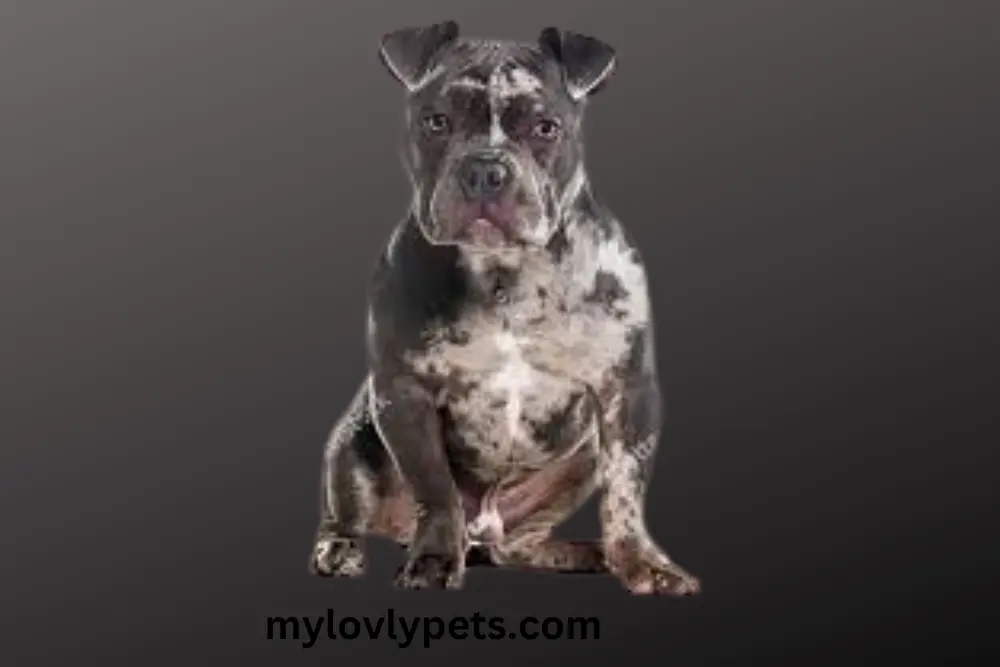
Merle American Bully: A Stunning Coat Pattern Like No Other!
Meet the Merle American Bully, a breed with coat patterns that will capture your heart. These dogs are famous for their extraordinary Merle patterns, featuring shades of blue or red that create a stunning and distinctive look. But beneath the beauty lies a story of genetic complexities and health worries.
Imagine a dog with a coat that looks like a work of art, with light and dark shades blending in harmony. That’s what a Merle American Bully offers. Blue Merles resemble tri-color dogs with a touch of faded black, while Red Merles exhibit a mottled red beauty. These patterns are mesmerizing and unique, making Merle Bullies a sought-after breed.
However, there’s a catch. Health concerns like deafness and eye problems are linked to the Merle gene, creating a dilemma for breeders and dog lovers. In this article, we’ll explore the beauty and the potential challenges of Merle coat patterns in American Bullies, helping you make informed choices for these exceptional dogs.
What is a Merle Coat Pattern?
Dogs with merle coat patterns are truly captivating, and it is of utmost importance to have a comprehensive understanding of their genetic foundations and potential health implications.
Merle is not just a color, but rather a genetic alteration that affects the distribution of pigment in a dog’s coat, creating a captivating array of shades. Within this captivating canine color spectrum, two primary merle variants, the blue merle and the red merle, are particularly striking.
What is the Genetic Pattern of Merle?

The presence of the merle gene (M) is responsible for creating merle patterns. This gene adds an intriguing element to a dog’s coat, resulting in patches of hair with a lighter color. When one parent passes on the merle gene to the offspring, they inherit a single copy (Mm), which allows merle patterns to emerge. Dogs without the merle gene (mm) do not have this gene, which is why they have solid coat colors.
Blue Merles: A Delicate Balance of Tones
Blue merles have a unique twist, often resembling tri-color dogs with black, white, and tan. The black patches have a slightly faded or even grayish appearance. These dogs display a range of tones, from pale coloration to bold patches, creating a distinct and beautiful coat.
Red Merles: A Mottled Elegance
Red merles display patches of red with a mottled appearance. They may not exhibit the same vibrant tan markings as blue merles. The coat of the red merle displays a captivating mosaic of varying shades of red.
What is the Inheritance Pattern of The Merle Gene in American Bully Puppies?
The Merle gene is an intriguing and unique genetic trait discovered in American Bullies, which has a significant impact on their coat color and patterns. American Bullies with the Merle gene showcase distinctive coat patterns, as certain patches of hair exhibit a diluted pigment. Blue Merles and Red Merles are variations that breeders and owners commonly refer to, but they are worth noting.
It is crucial to comprehend the inheritance of the Merle gene. Usually, Merle American Bullies receive the dominant gene from one parent, marked as (Mm), while non-Merles inherit two non-Merle genes (mm). When a Merle (Mm) is bred with a non-Merle (mm), there is a 50% chance that the resulting litter will carry the Merle gene.
When two Merles (Mm x Mm) are bred together, there is a 25% chance of producing double Merles, also known as double Dapples. Unfortunately, these dogs are prone to serious health issues such as eye and ear abnormalities, blindness, and deafness.
Responsible breeding and ownership of American Bulldogs requires an understanding of the significance of the Merle gene in coat color and any potential health concerns.
Health Concerns with Merle Coat Patterns

Research findings from the National Academy of Sciences of the United States of America have provided valuable insights into the health issues associated with the merle gene. Research has uncovered a concerning trend regarding deafness in dogs with the merle coat pattern, indicating a higher incidence of hearing problems.
For instance, it has been noted that Dachshunds with the merle gene may experience different levels of hearing loss, ranging from mild to complete deafness. The absence of this association in non-merle dogs highlights the clear correlation between the gene and auditory issues.
In addition, these studies also emphasize a notable increase in the occurrence of eye abnormalities in merle-coated dogs when compared to dogs without merle coat.
Although there have been discussions about potential health concerns related to the merle gene, such as skeletal, cardiac, and reproductive abnormalities, the evidence supporting these claims is still inconclusive.
It is important to emphasize the importance of responsible breeding practices and the avoidance of merle-to-merle breeding in order to reduce the likelihood of producing dogs with significant health problems. As breed enthusiasts, it’s crucial to prioritize the well-being of our canine companions and make sure their health isn’t compromised for the sake of aesthetic traits such as the merle coat pattern.
What is a Double Merle and How is it Created?
In the world of dog breeding, a “double merle” refers to a genetic condition that develops when two merle-coated dogs are bred together. Merle is a coat pattern that creates a marbled or mottled appearance in a dog’s fur due to patches of diluted pigmentation. When two merle-coated dogs are bred together (typically represented as “Mm” x “Mm”), their offspring have a 25% chance of being born as double merles, commonly referred to as “lethal whites.”
Double merles have two copies of the merle gene (MM), resulting in a coat that is mostly white with patches of merle. Nevertheless, the genetic combination has implications that go beyond mere aesthetics.
Double merles are prone to a range of health issues, such as abnormalities in their eyes and ears. They frequently experience significant hearing and vision impairments as a result of insufficient pigment in the corresponding organs. These challenges have a noticeable impact on their overall quality of life.
What are The Specific Challenges and Concerns Related to Merle American Bully?

An attractive and distinctive attribute of American Bullies is their merle coat pattern. It appears as marbling or speckling of color all over the coat, giving it a distinctive visual quality. Despite its widespread acceptance, Merle American Bullies necessitate careful thought.
The marbling effect is most noticeable in blue merles and red merles; the former resembles a faded tri-color dog, while the latter have mottled red areas. However, the existence of the merle coat pattern within the American Bully breed has led to unique difficulties and worries.
First and foremost, there is serious cause for concern over the health effects of the merle gene in American Bullies. Ocular and auditory problems, like as deafness and eye abnormalities, have been associated with this pattern. Despite mounting evidence of these dangers, there is ongoing discussion over the full scope of associated health issues.
Additionally, union with two merle-coated dogs can result in the breeding of double merles, which is associated with a high risk of serious health problems, most notably hearing, blindness, and other impairments owing to the lack of pigment. The American Bully community is worried about the ethical implications of breeding double merles and the potential suffering of the resulting puppies.
The deliberate breeding of two merles, with full awareness of the potential for producing double merles with significant health problems, is widely regarded as irresponsible and highly debated. Reputable breeders and kennel clubs strongly discourage such practices, and some even refuse to register dogs resulting from merle-to-merle breeding.
Both breeders and potential dog owners should be well-informed about the risks associated with double merles and prioritize the well-being of the animals over aesthetics. It is essential to gain a comprehensive understanding of the genetic mechanisms behind these coat patterns and their associated health problems in order to make well-informed decisions within the realm of dog breeding.
How can Responsible Breeding Practices Prevent the Occurrence of Double Merles?

When it comes to merle coat patterns in particular, responsible breeding techniques play a crucial role in protecting the health and well-being of dogs. The well-being of the animals in their care is always put first by ethical breeders and reputable kennel associations. They are aware that having two merle-coated dogs breed together can result in double merles, who are predisposed to a number of health problems (including deafness and blindness) from birth.
Reputable breeders avoid merle-to-merle breeding for the sake of the breed and to reduce the likelihood of creating two merles. They prevent any combinations that could produce double merle puppies when choosing mating couples, and they pay particular attention to genetic diversity.
Dogs born of merle-to-merle breeding are often disallowed from being registered with kennel clubs. These actions demonstrate how seriously we take protecting the breed’s genetics and well-being. In order to resolve the moral and health concerns related with merle coat patterns in dogs, responsible breeding procedures led by a genuine concern for the animals’ welfare are essential.
Accepted Merle Coat Patterns in Breeds
Here is a comprehensive list of recognized breeds that accept Merle coat patterns.
Australian Shepherd: is widely recognized as one of the most iconic breeds known for its stunning merle coat pattern.
Border Collie: It’s worth noting that Border Collies also have recognized Merle coat patterns. This breed can display a variety of eye-catching coat colors due to the presence of the merle gene.
Catahoula Leopard Dog: It is recognized for its distinctive and captivating coat colors and patterns, including the acceptance of merle patterns.
Cocker Spaniel: Merle coat patterns are recognized in Cocker Spaniels, contributing to the breed’s diversity in coat colors.
Dachshund (Dapple): Dachshunds display a range of coat patterns, including the captivating dapple, which is highly valued and embraced within this breed.
Also, read:
What is a Merle Cockapoo? A Dainty Designer Dog Breed
Final Thought on Merle American Bully
Ultimately, the coat patterns of the Merle American Bully contribute to their undeniable allure and distinctiveness, while also presenting certain complexities related to their health. It is important to consider the connection between the merle gene and issues such as deafness and eye abnormalities.
It is crucial to grasp the potential dangers linked to double merles and advocate for responsible breeding practices. Although merle coat patterns may be accepted in certain breeds, it is crucial to carefully consider the associated health concerns.
When considering adding a Merle American Bully to your family, it’s crucial to make well-informed choices, prioritize responsible breeding, and prioritize the overall well-being of these dogs. It’s important to avoid breeding merle-to-merle to minimize health risks and ensure the breed’s welfare.


